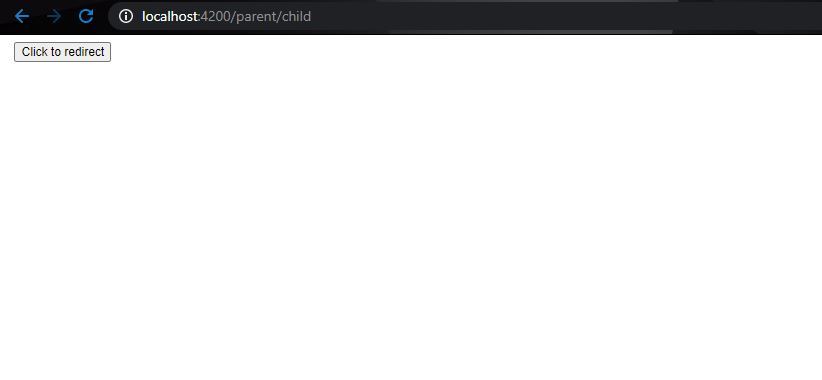在angular中如何从一条子路线导航到一条父路线
在angular中,一个根组件是所有组件的父组件,其他的组件可以被称为根组件的子组件。这个结构是以树的形式存在的,作为子组件的父组件位于子组件的上方,它们之间没有直接的联系,但一般来说,父组件可以通过两种方式从子组件中获取。
- 在子代与父代联动的情况下,直接使用routerLink指令。
- 使用Route类,以便在触发的事件中发生导航。
步骤:
在执行上述两个操作之前,有必要在位于app-routing.module.ts文件内的Route类的实例中注册这个组件。这将被进一步用于从子代到父代的导航。
路由应该在app-routing.module.ts文件中定义,如下。
import { NgModule } from '@angular/core';
import { Routes, RouterModule } from '@angular/router';
import { ParentComponent } from './parent/parent.component';
import { ChildComponent } from './parent/child/child.component';
const routes: Routes = [
{path: 'parent' , component: ParentComponent},
{path: 'parent/child' , component: ChildComponent}
];
@NgModule({
imports: [RouterModule.forRoot(routes)],
exports: [RouterModule]
})
export class AppRoutingModule { }
一旦完成,这两种方法中的任何一种都可以用来从一个子项目中路由到父项目。
语法:
要在angular中为任何组件注册路由,在app-routing.module.ts文件中设置组件的路径和类名。其语法如下。
import { Routes, RouterModule } from '@angular/router';
import { Component_1 } from 'path_to_component_1';
import { Component_2 } from 'path_to_component_2';
const routes: Routes = [
{path: 'URL_mapping_component_1' , component: Component_1},
{path: 'URL_mapping_component_2' , component: Component_2}
];
由于组件与网页不同,因此要用适当的URL路径来注册,这将把各自的路径映射到各自的组件。
基本的例子和解释
- 使用routerLink指令。
这是一个最简单的方法,可以用来重定向到整个项目的任何组件。它在模板中作为一个选项使用,相当于锚标签中的href选项,不同的是,它将一个锚链接到angular项目中的组件。
它被用作锚标内的指令。子模板文件代码给出如下。
<!DOCTYPE html>
<html lang="en">
<head>
<meta charset="UTF-8">
<meta name="viewport"
content="width=device-width,
initial-scale=1.0">
<title>Document</title>
</head>
<body>
<a [routerLink]=
"[ '/parent']" [queryParams]="{GfG: 'Geeks for Geeks'}">
Redirect message to parent
</a>
</body>
</html>
routerLink被设置为父组件的路由。只是为了补充,queryParams指令被用来通过查询字符串向父组件发送消息。
在上级组件文件中,可以通过以下方式访问查询参数。
@Component({
selector: 'app-parent',
templateUrl: './parent.component.html',
styleUrls: ['./parent.component.css']
})
export class ParentComponent implements OnInit {
constructor( private activateRoute: ActivatedRoute) {
}
message = this.activateRoute.snapshot.queryParamMap.get('GfG')
ngOnInit() {
}
}
在消息变量中,参数被接收,消息被存储。它使用ActivatedRoute类进行捕捉。
<!DOCTYPE html>
<html>
<head>
<title>Page Title</title>
</head>
<body>
<p>On the Parent page </p>
<p>
Message By Child is {{message}}
</p>
</body>
</html>
- 使用Route.navigate()方法。
在这里我们将使用@angular/route模块中的Route类。路由对象是用来通过.ts文件的组件部分动态地路由到页面。这个对象有一个.navigate()方法来路由到不同的模块。它需要两个参数,第一个是路由路径,第二个是由要发送的查询参数信息组成的对象,与路由路径的相对性等。当需要通过模板有条件地触发一个事件时,该方法被使用。
import { Component, OnInit } from '@angular/core';
import { Router, ActivatedRoute } from '@angular/router';
@Component({
selector: 'app-child',
templateUrl: './child.component.html',
styleUrls: ['./child.component.css']
})
export class ChildComponent implements OnInit {
constructor(
private router: Router,
private activatedRoute: ActivatedRoute) {}
ngOnInit(){}
redirect_to_parent(){
this.router.navigate(["../../parent"], {
relativeTo: this.activatedRoute, queryParams:
{GfG: 'Geeks for Geeks'}});
}
}
上面的代码是针对孩子的组件文件的,在这个文件中,使用模板中的一个按钮触发了一个方法redirect_to_parent(),以执行重定向的动作,并向父组件发送一个信息。孩子的模板文件给出如下。
<!DOCTYPE html>
<html lang="en">
<head>
<meta charset="UTF-8">
<meta name="viewport"
content="width=device-width,
initial-scale=1.0">
<title>Document</title>
</head>
<body>
<button (click)="redirect_to_parent()">
Click to redirect
</button>
</body>
</html>
输出:



 极客教程
极客教程